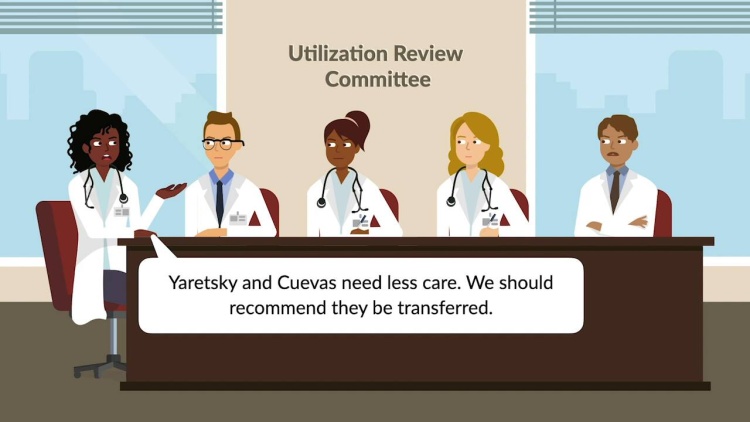Blum v. Yaretsky
United States Supreme Court
457 U.S. 991 (1982)
- Written by Megan Petersen, JD
Facts
Yaretsky and Cuevas (plaintiffs) were patients in the American Nursing Home, a high-level-care facility located in New York City. Both men received Medicaid benefits from the State of New York to pay for their care. As part of the conditions for nursing-home patients’ receipt of Medicaid benefits, the State of New York established a utilization-review committee (URC) to determine whether the nursing-home patients met the income requirements for Medicaid and whether they sought necessary medical treatment. Based on standard procedure, if the URC determined that patients required less or more care, it recommended to state Medicaid officials that patients be discharged or transferred to facilities offering different levels of care, with Medicaid benefits adjusted accordingly. In Yaretsky’s and Cuevas’s cases, the URC determined that they needed less care and recommended that they be transferred to a lower-level facility. After administrative hearings, New York City officials determined that Yaretsky’s and Cuevas’s Medicaid benefits would cease if they did not accept the recommended transfer. Yaretsky and Cuevas then commenced this suit on behalf of themselves and a class of Medicaid recipients in New York City nursing homes, naming as defendants Blum, commissioner of the New York Department of Social Services, and the commissioners of the Department of Health (defendants). Yaretsky and Cuevas alleged that Blum and the commissioners had not afforded them adequate notice of the URC decisions or their right to an administrative hearing to challenge those decisions. The district court granted Yaretsky and Cuevas injunctive relief, and the court of appeals, finding that state action occurred, affirmed. The United States Supreme Court granted certiorari.
Rule of Law
Issue
Holding and Reasoning (Rehnquist, J.)
Dissent (Brennan, J.)
What to do next…
Here's why 899,000 law students have relied on our case briefs:
- Written by law professors and practitioners, not other law students. 47,000 briefs, keyed to 994 casebooks. Top-notch customer support.
- The right amount of information, includes the facts, issues, rule of law, holding and reasoning, and any concurrences and dissents.
- Access in your classes, works on your mobile and tablet. Massive library of related video lessons and high quality multiple-choice questions.
- Easy to use, uniform format for every case brief. Written in plain English, not in legalese. Our briefs summarize and simplify; they don’t just repeat the court’s language.





